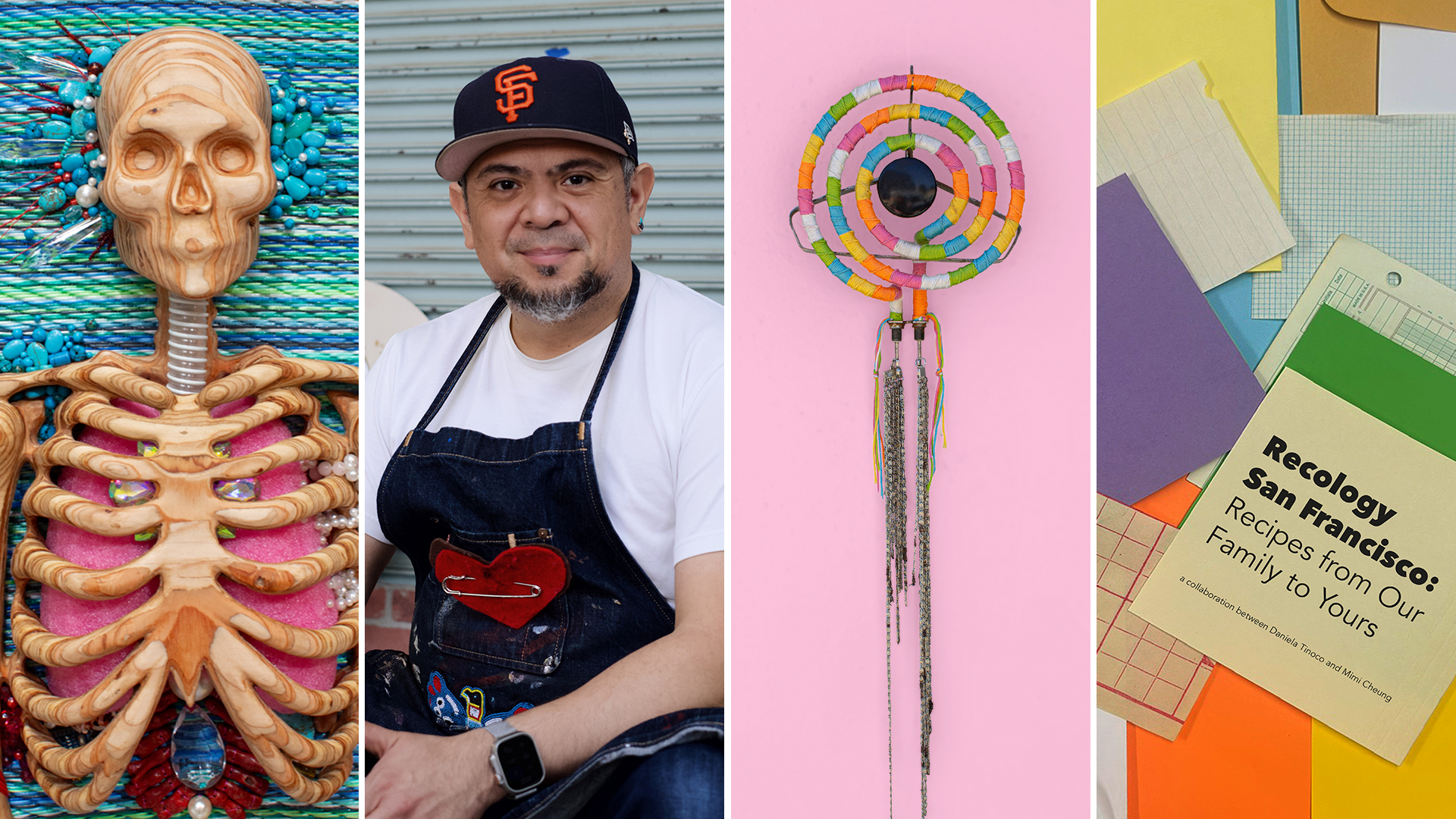
FOR IMMEDIATE RELEASE
The Artist in Residence Program at Recology San Francisco is thrilled to announce exhibition dates for current artists-in-residence Laurel Roth Hope, Josué Rojas, and SFSU MFA candidates Eleanor Scholz, and Daniela Tinoco.
Friday, May 16, 2025 from 5 – 8 PM
Saturday, May 17, 2025 from 12 – 3 PM
Tuesday, May 20, 2025 from 5 – 7:30 PM with artist talk by Eleanor Scholz & Daniela Tinoco at 6 PM (401 Tunnel), Josué Rojas at 6:30 PM (503 Tunnel), and Laurel Roth Hope at 7 PM (503 Tunnel).
Admission is free and open to the public – no reservation is required. All ages are welcome and the site is wheelchair accessible.
Location
Recology Art Studios
503 and 401 Tunnel Avenue, San Francisco
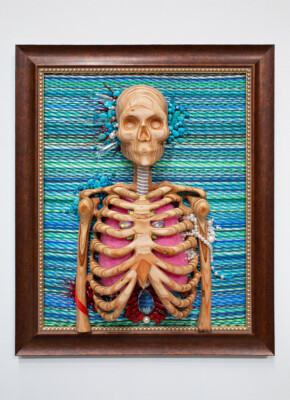 Laurel Roth Hope
Laurel Roth Hope
Body of Land, Body of Water
Across Laurel Roth Hope’s meticulously crafted series of sculptures, we see wooden, skeletal bodies caught in a state of indeterminacy, their internal systems laid open and vulnerable. They seem to be somewhere between summoning organs from our eternal consumer waste and slowly breaking apart, leaving behind the parts that stubbornly refuse to biodegrade back into the earth. The sculptures are seductive in their intricately crafted details: curving wood grain, beaded bursts of texture, wires laid in sinewy rows. The forms sink into the surfaces of the work, a plastic rope mat that suggests the span of an ultramarine ocean; a corporeal topography that roots the human figure within the landscape. As suggested through her title–Body of Land, Body of Water–these suggest an embodied cartography orienting us to our place in the environment and geologic time.
In past projects, Roth Hope has explored the impact humans have had on the rest of the natural world through sculptural forms using manufactured consumer goods to replicate animals and plants in painstaking detail. In this series, she turns that lens back on ourselves to explore the ways our industries, waste, and excesses impact us in turn. We are not separate from the ecosystem or our waste streams. The sculptural bodies in the exhibition have been stripped down, beneath individual identifiers and features, revealing a common human-ness that has become inextricable from the surrounding earth, even in its artificiality.
As plastics and chemicals leach into the environment to move through the food chain, slowly accumulating in our bodies, we must remember that our survival and well-being has never been, and will never be, independent from the earth’s health as a whole. Our world demands reciprocity, yet so many of our values and systems reinforce practices of extractive consumption. By asking us to consider these skeletal bodies–their delicate interiors reminding us of our mortality even as they are remade with scavenged discards that will last long past any of our lifespans–we must stretch our sense of time and responsibility. How might our perspective shift if we truly understand ourselves within a larger ecosystem?
Laurel Roth Hope is a self-taught artist born and raised in the San Francisco Bay Area. Prior to becoming a full-time artist, she worked as a park ranger and in natural resource conservation. Hope was a 2020 Space Program SF Resident Artist, a 2017 Smithsonian Artist Research Fellow, and a 2016 Resident Artist with the Kohler Arts and Industry program in Wisconsin. In 2013, she and her sometime collaborator, Andy Diaz Hope, completed a year-long Fellowship at the de Young Museum of San Francisco examining the history of human cooperation through architecture. She was included in the Renwick Gallery of the Smithsonian’s 40 Under 40 exhibition in 2012. Her work is included in the permanent collections of the Smithsonian, the Museum of Art and Design in New York, the Mint Museum, Crystal Bridges Museum of American Art, 21C Museum, the Zabludowics Collection, the Progressive Collection, and the Ripley’s Museum of Hollywood, among others. She is represented by Catharine Clark Gallery of San Francisco.
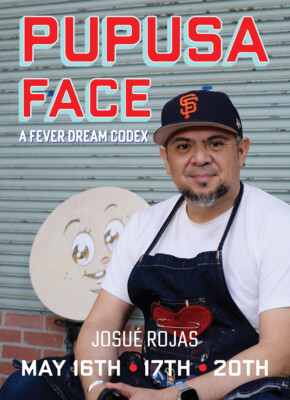 Josué Rojas
Josué Rojas
Pupusa Face: A Fever Dream Codex
In a series of colorful, sprawling paintings, Josué Rojas leads us through a loose narrative navigating a contemporary experience that the artist likens to a fever dream. Our guide on the journey is a smiling “pupusa face” character that serves as a stand in for the San Francisco-rooted Salvadoreño-Californio artist as he moves through what he describes as an “urban surrealist” stream of popular and hyperlocal references, Salvadoran La Palma-style folkloric motifs, reimagined Americana and pop culture iconography, and looping graffiti letterforms. This amalgamated landscape reflects Rojas’s bilingual painting background in Mission District mural traditions and Western studio training. Swooping bubble style graffiti reading “Vai-Vén” (back and forth) suggests his sway between cultural frameworks, identities, geographies, and artistic languages. He underscores this duality with recurring references to W.E.B. Du Bois’s concept of double consciousness emblazoned across signage that appears in a sea of dense iconography and painterly abstraction.
Like Du Bois, this strategic awareness across cultural frameworks is a form of survival. While the bright palette and cartoon friendly characters are appealing and welcoming, there is a quiet sense of tension underscoring this expansive visual tale. While Rojas pulls and remixes a wide range of references, high and low, from across his life, they still evoke power and hierarchies of cultural value.
By describing this approach as gritty urban surrealism, Rojas not only speaks to the nonlinear dreaminess of the visual narrative winding through the gallery, but a long tradition of painters who have used the form to envision an unfettered social imaginary beyond the constraints of their day-to-day realities. In that sense, the joyfulness evident in Rojas’s work, amidst the fever dream, expresses a stubborn desire to blaze a path through the chaos.
Josué Rojas is a Salvadoran-American, San Francisco based painter, muralist, fine artist and educator with over two decades of experience in fine arts, muralism, community arts, and arts leadership in the San Francisco Bay Area and beyond. Before going independent as a full-time artist, Rojas worked as a bi-lingual journalist for 15 years with Pacific News Service/New America Media and then went on to be Executive Director of Acción Latina, proud publisher of El Tecolote Newspaper (est. 1970), California’s longest-running bilingual newspaper. Rojas’s work has been exhibited at the San Francisco Museum of Modern Art’s Koret Education Center, Incline Gallery, Arion Press, Acción Latina’s Juan R. Fuentes Gallery, and was featured in Juxtapoz, Hyperallergic, the San Francisco Chronicle, El Tecolote, and Mission Local. His mural work is on public display at Balmy Alley and on the streets of San Francisco.
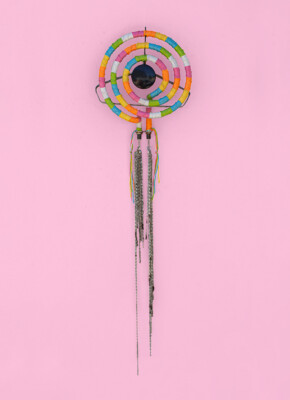 Eleanor Scholz
Eleanor Scholz
Medusa Blooms
Due to climate change and nutrient runoff from industrial agricultural processes, jellyfish blooms have become recurring events in warmer zones within our oceans. Seas explode with beautiful but threatening masses of their undulating forms. In Medusa Blooms, Eleanor Scholz takes inspiration from this phenomena, looking to the jellyfish as ethereal heralds warning of ecological systems out of balance. Scholz populates the gallery with a variety of biomorphic sculptures, their bodies and trailing curtains of tentacles created from post-consumer discards, including wire frames, cages, ribbon, cable, and costume jewelry.
The methodical detail in the work reflects Scholz’s interest in material kinship–our continuing relationships to our things, including what we’ve consumed and thrown away. The rhythmic practice of weaving these forms–as well as the scavenging for supplies–is a process of artistic mindfulness. Repeated actions and close observation requires a focused care and intimacy that refigures our consideration of the things we’ve cast aside. As observers, we are invited to consider the patterns and radiating spirals within the talismanic forms, anchoring our attention in the layering and contrasts of textures.
Scholz grew up watching her grandmothers weaving at their looms and here she taps into that matrilineal inheritance to shift her (and our) relationship to these materials. Instead of the casual cycle of extracting, buying, and discarding, she imbues the work with the deliberate intimacy of handcraft that breaks the ease of quick consumption. Through this creative ritual, she asks us to appreciate the slow accumulation of small gestures in building a larger whole, offering us a potential path to acting on the exhortations of the jellyfish to right our relationships with the earth.
Eleanor Scholz is a San Francisco based visual artist, currently pursuing her MFA in Studio Art at San Francisco State University. Using multiple illustrative, printmaking, and craft mediums, she creates devotional artwork about the environment, and the interplay between natural processes and the manmade. Scholz is particularly interested in elevating and reverently tending to discarded items and derelict spaces—gestures of care that help her imagine alternative and hopeful futures founded on compassion, curiosity, and respect.
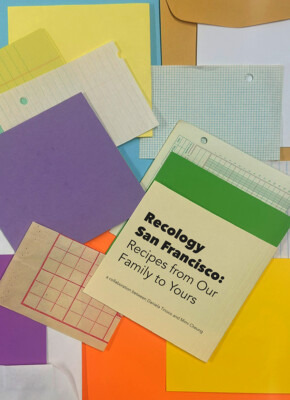 Daniela Tinoco
Daniela Tinoco
Recipes from Our Family to Yours
Through Recipes from Our Family to Yours, a collaborative project with Recology’s Mimi Cheung and other contributors, Daniela Tinoco explores potlucks as a space of mutual care, where everyone contributes and is fed. The exhibited work takes the form of a zine recipe collection and series of layered Riso print collages that document and give insight into the social space Tinoco and Cheung organized with Recology staff from across the Tunnel Avenue site. After being invited to a staff potluck early in her residency, Tinoco met Cheung and was inspired to highlight the camaraderie and community building taking place amongst the people behind what might otherwise be perceived as a monolithic institution. She made plans with Cheung and cooked pots of champurrado to share as she visited employee-owners to invite them to contribute to the cookbook and next potluck.
Potlucks and community cookbooks have long been staples of gathering and relationship building–bringing together groups from friends and families to community organizers. In a potluck, we rely on one another to bring the pieces that in aggregate will be enough for everyone. The contribution of food represents a commitment to the group, as well as a curiosity about what others might introduce to your palate–and what we might learn about colleagues in the process. Each individual dish is a cultural inheritance and story to be shared, while being a part of the larger whole.
Tinoco’s practice often carries this ethos of reciprocity and communion independent of official channels–whether a company or a nation. In that autonomous space, she often finds collaborators who might not consider themselves artists and invites them to build shared meaning and honor the practices of everyday life that will continue well beyond the temporary spotlight of an artistic project. The formal construction of the framed prints and cookbook using a variety of papers scavenged from the Public Reuse and Recycling Area reflects the polyvocality of the process–irregularly shaped pages and leaflets that hold the uniqueness of each person’s story and contribution to the group’s nourishment. Through these recipes, Tinoco and Cheung remind us that we can practice care and get what we need from one another.
Daniela Tinoco is a transdisciplinary artist from Cholula, Mexico, currently living on Ohlone Land and pursuing her MFA in Art Practice at San Francisco State University. She is a co-founder of the annual Enero Zapatista Bay Area and has exhibited her work at the Berkeley Art Center, ATA Right Window, and SOMArts. Tinoco is the recipient of the 2024 Edwin Anthony & Adelaine Boudreaux Cadogan Scholarship and a member of the research group Autonomous Imaginaries: For Collective and Counter-Hegemonic Artistic Practices at the UC Berkeley Center for Race and Gender Studies.
About the Artist in Residence Program
The Recology San Francisco Artist in Residence (AIR) Program, a part of Recology’s Sustainability Education Program, is both an art and education initiative that provides Bay Area artists with access to discarded materials, an unrestricted stipend, and individual studio space. During their four-month residency at the San Francisco Transfer Station, artists create a body of work and host studio visits for children and adults, fostering public awareness about the importance of preserving natural resources.
Since 1990, over 190 professional artists and 60 student artists from local universities and colleges have participated, working across disciplines—including new media, video, painting, photography, performance, sculpture, and installation—to explore a wide range of topics.
Through this program, artists inspire new perspectives on sustainability by educating thousands of individuals each year about the importance of environmental stewardship.